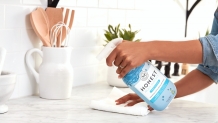
The Different Components of Cleaning Products
It seems like there are a million cleaning products on that market and there are a ton of different components in cleaning products. I used to just pick a cleaning product based on the label and price and go to town. I now dig a little deeper into the ingredients. This post is to simply explain some of the types of ingredients found in cleaning products and what they are used for. These types of ingredients are found in plant-based and conventional cleaning agents
The Different Components of Cleaning Products
pH: Acidic, Neutral, Basic
Surprisingly, the pH of a cleaning product is a cleaning agent in itself. The pH plays a huge role in determining the safety and performance of cleaning products. The pH is measured on a scale from 0 to 14. A pH of 7 is neutral and anything less than 7 is an acid and greater than 7 is a base or alkaline, the closer to 0 and 14 the pH, the more acidic or basic the substance.
The closer a pH is to neutral, the less damage to people, the environment, and surfaces can be caused because of the pH. Products that are very acidic or basic can damage surfaces, cause water toxicity, and be dangerous to inhale or contact the skin.

Acids are useful in breaking down rust, stains, and mineral build-up. Cleaning product used to clean toilet bowls, remove rust or stains, clean mold or tile, and remove mineral build-up are often acids. Common acids in cleaning agents include citric acid (lemon juice) and acetic acid (vinegar).
Bases cause a chemical reaction called saponification. This occurs when oils or fats mix with a basic cleaning solution and form a “soap,” removing the fats and oils. This makes bases great cleaners for removing grease and oils. Most soap has a pH of 9-10 which helps removes oily substances. Common cleaners that are bases are oven cleaners, laundry detergents, degreasers, and all-purpose cleaners. Ammonia and bleach are common base used in cleaning.
Surfactants
Surfactants are used to lower the surface tension of water. This makes the water “slippier” and the water particles not want to interact with other water particles. Instead of interacting with other water particles, they interact with grease and dirt. This allows the water particles to better “trap” and remove grease and dirt. There are different types of surfactants, anionic, cationic, nonionic, and amphoteric, that work better on different types of substances. A classic surfactant is soap.

Solvents
Solvents have two rolls in cleaning products. The first role is to dissolve stains and dirt. This allows it to be removed easier. The second role is to make the different components of the cleaner more soluble and create a more stable cleaning solution.
Oxidizing Agents
Oxidizing agents are used on stains that contain color to get rid of the color. They are not used to get rid of grease or particles. They work as a stain remover by breaking the bonds that allow you to see that color. This causes the substance to become colorless. Bleaches are a common oxidizing agent. When someone says “bleach,” we normally think of chlorine bleach, but there are other types of bleach.
Enzymes
Enzymes are proteins used to break particles down into smaller particles. There are a variety of enzymes that are used in cleaning agents and they work on different types of substances. They are most commonly found in laundry and dishwasher detergent but are being used in more types of cleaning products.
- Lipases: used to break down fats such as oil and grease
- Amylases: used to break down starch molecules such as gravy and pasta
- Proteases: used to break down proteins such as grass, egg, chocolate, and sweat

Chelating or Sequestering Agents
These agents bind to metal ions and prevent surfactants and other cleaning products from being used on them. They allow other cleaning agents to do their job. They are commonly used to soften water.
Buffers
Buffers are added to cleaning products to create the desired final pH if the sum of all the parts does not yield the desired pH.
Emulsifiers
We know that oil and water do not mix. Emulsifiers are used to break oils and greases up into tiny globules that then can be suspended in water. They are used in some cleaning formulations to help combine the different agents. They are also used in some cleaning products to suspend dirt and oils and prevent it from settling back onto the surface that was cleaned. These are sometimes called stabilizers.
Preservatives
It may seem odd that cleaning products need preservatives, but they do. Many cleaning products are broken down by bacteria, especially biodegradable products. Preservatives prevent bacterial degradation while the product is still in the bottle. They also can prevent soaps from going rancid due to oxidation.

The Different Components of Cleaning Products Conclusion
There are many different components of cleaning products and the roles of them in cleaning are changing. Traditionally acids and basis were the main components of cleaning agents. There have been huge developments with bio-based surfactants that now allow for many more cleaning products that are more pH neutral and rely on surfactants and solvents to clean. The development of enzymes has had a big impact on dishwashing and laundry detergents. Most cleaning products are comprised of multiple different cleaning agents.
When using a cleaning product it is important to know what exactly it is good at cleaning and what it can damage. Doing my cleaning product reviews, I have noticed that many cleaning product claims, do not match up with the ingredients.
I briefly touched on the science behind the different types of cleaning agents. If you want to dig deep into the science of the different components of cleaning products, including the specific reactions that happen, the University of Kansas has published a very science-focused guide.


